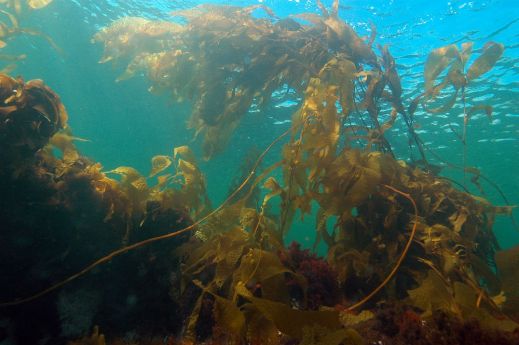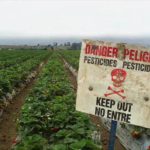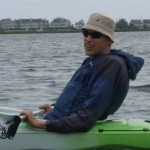This is a guest post by one of our most fabulous DSN Scientist in Residence and shanty singing partners, Jarrett Byrnes. Jarrett is a professor at the UMass Boston where he studies food web complexity.
There’s something I’ve always wanted. Something that would take kelp forest science to a new level. Something that would let me do the kind of work that I dream about, quietly, secretly, peering into the mysteries of kelpiness.
![]() It is something impossible.
It is something impossible.
It is a time machine.
And now I have one. But with a catch. For you, my dear friends, are its pilot.
OK, OK, first, why use a time machine as a tool of science, and not, I don’t know, to right wrongs and make the world a better place? Well, first off, temporal paradoxes, y’all. Come on. Be realistic. Has Doctor Who taught us nothing? Or decades of Star Trek? Or Primer? (seriously, see that last one, as it will hurt your brain in a good way).
But then, why, kelp? What? Hear me out.
There are so many things that we as marine biologists want to know about the state of ecosystems in the past. For many things, we hardly ever have records that are older than ten usually for just one small area. This is really problematic – especially for something like Giant Kelp.
You see, Giant Kelp (that’s Macrocystis to you!) is kind of the bad-ass of the algae world. It’s pretty damn huge – up to 60m long in some places – and grows up to a foot or two a day. It’s so damn big, we can see it from orbit1.

It’s also everywhere – from Alaska to Baja to South Africa to much of South America to New Zealand to the sub-Antarctic islands. And, according to the Lane et al. phylogeny, it’s all one species2. It gets *around*. And wherever it is, it feeds, houses, and nourishes much of the life in the sea around it.
So, where does the time machine come in, and why are you piloting it?
Simply put – Keeeelllppp Innnnnn Spaaaace!
The Landsat family of satellites have been orbiting earth, taking photos of the whole globe twice a month since the early 1980s. Photos where we can see kelp. They are a time machine we as scientists can use to go back and see how kelp has changed over thirty years.
Can we see the near-extinction of giant kelp from Tasmania? Can we see it moving around the coast of South Africa? Has it been walking away from the warming equator? Is there more or less now than there was in the past?
OK, this sounds pretty cool. But where do you, our time-traveling pilots come in?
Basically computers suck.
OK, no, really, we love them. *pets shiny Apple laptop* BUT – they cannot tell kelp from waves or clouds in the Landsat images. My collaborators (the real remote sensing part of this team) have tried. It’s a no-go. We actually need people – kelp hunters, if you will, to peer at the millions of images of potential kelp habitat and help us discover these Floating Forests.
We need you.
Working with the Big Momma of online citizen science, Zooniverse, my collaborators from the Kelp Ecosystem Ecology Network (KEEN) and I have created an online citizen science project called Floating Forests. In it, we ask you to take a look at images. Help us cull out bad ones (they’re satellites – they take pictures cloudy cloudy rain or (often still cloudy) shine, or take pictures of more than we think.
And if you see kelp, circle it!

It’s really quite meditative to see images of the land and see whisk by, pausing periodically to lasso a green bed of kelp.
Maybe you’ll see a wave-swept vista of Point Lobos. Maybe you’ll see the Googleplex (I did – by accident). Maybe you’ll see somewhere you’ve never dreamed of traveling, but with that big kelp bed sitting there, you know the destination of your next dive trip.
So, please, go hop into the pilot’s stick of this magical kelpy time machine. Poke around. And ask questions! We scientists are there to talk to you! What are you waiting for?

References:
1.Cavanaugh, K., D. Siegel, D. Reed, and P. Dennison. 2011. Environmental controls of giant-kelp biomass in the Santa Barbara Channel, California. Marine Ecology Progress Series 429:1–17.10.3354/meps09141
2. Macaya, E. C., and G. C. Zuccarello. 2010. DNA barcoding and genetic divergence in the Giant Kelp Macrocystis (Laminariales). Journal of Phycology 46:736–742. 10.1111/j.1529-8817.2010.00845.x







Jarrett, if people can spot the kelp with their eyes on pictures, could remote sensing software not use the pixel value (wavelength) as a way to train the software to classify the kelp in the images? Unless each image has a different reflectance.
Andrew, theoretically yes. We have been working on this problem for a few years now and we are improving our automated detection algorithms. However, we have found that producing high quality data still requires some manual editing/clean-up of those automated classifications. Even a small amount of manual editing quickly becomes time consuming when we have to check each image. Here are a few of the reasons why this manual editing is necessary: (1) The kelp canopy has a weak reflectance signal, it is right at the lower limit of what is detectable by Landsat. (2) Many detection algorithms get confused by sunglint, breaking waves, algal blooms, mudflats, etc. (3) Atmospherically correcting coastal scenes is difficult and so there are some reflectance differences among scenes.